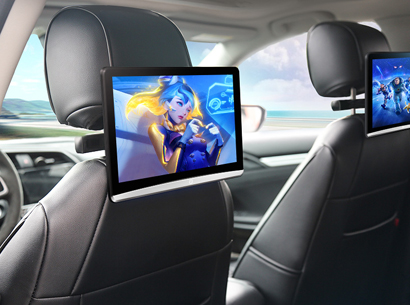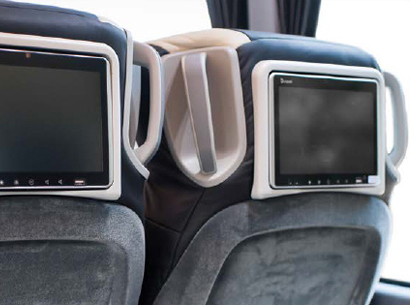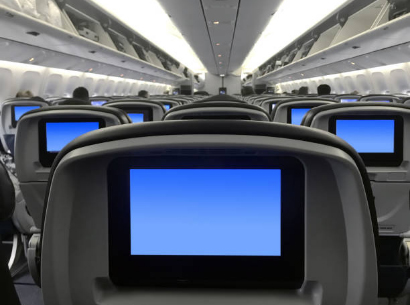Our Systems
Our patent-pending infotainment systems are engineered to deliver high-quality entertainment and informational content across diverse settings, from stationary to mobile environments, with centralized management for efficiency and reliability.
Personal Account Profiles
Users can create/login to a personal ad account profile that tailors ads to thier preferences and interests
Bluetooth and Standard Aux
In addition to a standard headphone jack, our units can pair with a user's bluetooth headphones or earbuds
Proprietary Ad Network
Our ad network and system seeks to improve the user experience and take advantage of our technology
Modular Design
The backplate of the infotainment device is removable and designed for mounting to various seatback styles
Rugged, Reliable, Secure
Our infotainment systems are field tested under harsh conditions to ensure safe, long-lasting performance
Streaming Shows with our Ads
Users may log into subscribed streaming service, playing with our ads, like a Roku, Freevee, or VidAngel application
2-Way Sales Engagement
Our systems enable 2-way communication; for example, a company could pitch timeshares live to users
Eye Tracking
The 8MP camera paired with AI tracking software enables hyper accurate user ad engagement data
Redeemable Rewards
Users may have the option to comp their travel or earn rewards in exchange for quality ad engagement
Mercury

- Purpose and Environment: The Mercury Infotainment System is designed for stationary settings like hotels, residential complexes, internet cafes, and corporate offices.
- Display Features: Equipped with individual high-resolution LED displays (minimum 1920x1080 pixels) for personalized user experiences in rooms, cubicles, or booths.
- Centralized Management: Powered by a high-performance server with a multi-core processor and scalable storage, managing data distribution.
- Data Throughput: Capable of handling up to 10Gbps, ensuring efficient delivery of multimedia content.
- Content Delivery: Distributes streaming video, interactive applications, and real-time information via wired Ethernet or fiber-optic networks.
- Content Management: Features advanced software for remote scheduling, updating, and monitoring of content with minimal latency.
- Scalability and Integration: Seamlessly integrates with building management systems (BMS) and supports IoT protocols for customization and energy efficiency.
- Security: Incorporates AES-256 encryption to ensure secure data transmission and protect user privacy.
Mars

- Purpose and Environment: The Mars Infotainment System is designed for mobile environments like buses, trains, and mass transit vehicles.
- Display Features: Each passenger seat has a compact, high-definition touchscreen (minimum 1280x720 pixels) mounted on headrests, built to withstand vibrations and temperature changes.
- Centralized Data Unit: Powered by a ruggedized server with a solid-state drive (SSD) and a low-power, high-efficiency processor tailored for mobile use.
- Connectivity: Supports 4G/5G and satellite-based communication for uninterrupted content delivery in remote or low-signal areas.
- Content Distribution: Uses a proprietary protocol to stream high-quality video, audio, and interactive content, supporting up to 50 simultaneous streams per vehicle with minimal buffering.
- Power Management: Includes features to optimize energy use, and automotive-grade standards like ISO 16750.
- Maintenance and Updates: Offers real-time diagnostics and remote firmware updates for reliability and adaptability in fleet operations.
- User Interface: Customizable interfaces with support for multiple languages and accessibility features.
Apollo

- Purpose and Environment: The Apollo Infotainment System is designed for commercial passenger aircraft, offering a superior in-flight entertainment experience.
- Display Features: Each seat has a high-definition touchscreen display (minimum 1920x1080 pixels) embedded in the headrest, meeting aviation standards like DO-160G.
- Centralized Data Unit: Powered by an avionics-grade server with fault-tolerant architecture, redundant power supplies, and high-speed solid-state storage for reliable operation.
- Connectivity: Supports satellite-based Ku-band or Ka-band networks for real-time streaming of HD video, live TV, and internet services to up to 300 displays.
- Content Management: Uses a secure, cloud-integrated platform for customized content like movies, games, and flight information, with low-latency delivery via optimized caching.
- Cybersecurity: Complies with aviation cybersecurity standards, featuring end-to-end encryption and multi-factor authentication for administrative access.
- Integration: Syncs with aircraft cabin management systems for coordinated content delivery.
- Accessibility: Includes features like closed captioning to enhance user accessibility.